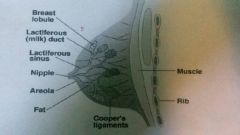![]()
![]()
![]()
Use LEFT and RIGHT arrow keys to navigate between flashcards;
Use UP and DOWN arrow keys to flip the card;
H to show hint;
A reads text to speech;
14 Cards in this Set
- Front
- Back
|
Ovaries |
Contain follicles which contain OOCYTES (eggs). |
|
|
Oogenesis |
Process of egg production. |
|
|
Oogonia (Before Birth) |
Female stem cells produced- do not exist after birth. Turn into primary oocytes and push into ovaries. |
|
|
Primary Oocytes (After Birth) |
Become primary follicles waiting for puberty (10-14 years) to undergo meiosis. At puberty FSH is released stimulating follicles to mature into oocytes (eggs). |
|
|
Follicles |
Developing follicles secrete ESTROGEN AND PROGESTERONE depending on needs of the egg cells. |
|
|
Ovulation |
When egg is mature and follicle ruptures releasing oocyte. Triggered by the release of luteinizing Hormone (LH) by pituitary gland. During ovulation the egg will burst from the follicle - then what is left of the follicle will become the corpus luteum. Estrogen and progesterone is reealeased to assist in case of pregnancy. |
|
|
Uterine Tubes |
Fallopian tubes, oviducts. Used to conduct/ guide the egg from the ovary to the uterus. Fimbriae surround the opening of the tube. Cilia sweep oocyte into the tube. Fertilization occurs in the uterine tubes. |
|
|
Uterus |
Muscular organ where an embryo will implant and a fetus will grow. |
|
|
Endometrium |
Inner wall - mostly epithelial tissue. |
|
|
Cervix |
Opening of uterus through which baby will pass - opens to 10cm. |
|
|
Vagina |
Receives sperm during intercourse. Allows menstrual flow and childbirth. |
|
|
Mammary Glands |
Organs of milk production - located in breasts. |
|
|
External Structure (mammary) |

Nipple, areola. |
|
|
Internal Structure (mammary) |

15-20 glandular lobes covered by adipose tissue. Within each lobe are alveolar glands that produce milk and send it through the lactiferous ducts. |

